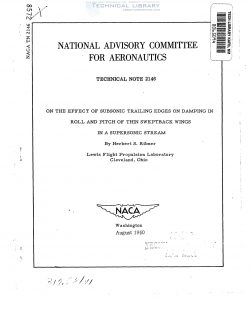naca-tn-2146
- Version
- 146 Downloads
- 1.04 MB File Size
- 1 File Count
- December 9, 2016 Create Date
- December 9, 2016 Last Updated
National Advisory Committee for Aeronautics, Technical Notes - On the Effect of Subsonic Trailing Edges on Damping in Roll and Pitch of Thin Sweptback Wings in a Supersonic Stream

The principal effect of subsonic trailing edges on the damping
in roll and pitch of thin sweptback wings in a supersonic stream is
evaluated with the aid of some conical and quasi-conical flows pre-
viously derived. This effect is expressed in the form of approximate
correction terms to be added to the corresponding expressions that
are obtained when the trailing-edge disturbance is ignored. The
results are limited to those plan forms and Mach numbers for which
the trailing-edge disturbance does not extend beyond the leading edge
and for which the area of mutual interference between tips and trail-
ing edge is not large. Practical applicability is subject to the
limitations of linearized potential theory.
At supersonic speeds the flow over a sweptback wing is closely
related to the flow over a triangular or delta wing (fig.‘l(a)) with
the same leading-edge sweep angle. Thus, in figure l(b), the flow
characteristic of the delta persists out to the tip Mach cones.
Within the tip inch 601193 the flow is altered. (See reference 1.)
At lower supersonic speeds (fig. 1(C)), the conical Mach wave from
the apex of the trailing edge encloses a portion of the trailing edge.
Here also the basic delta flow is altered. (At these speeds the com-
ponent stream velocity norml to the trailing edges is subsonic and
the edges are termed "subsonic."
m altered flow in the tip and trailing-edge regions my be
considered to result from superposing on the basic delta-wing flow
certain necessary additional flows. These additional flows have the
function of canceling the delta-wing lift outside the wing tips and
behind the trailing edge. These cancellation flows yield the dis-
turbance pressures in the tip regions and, if the edge is subsonic, '
in the trailing-edge region.
According to figure l(c), the tip and wailing-edge disturb-
ence regions overlap. In the cross-hatched upper portion of the
overlap, for each tip, the trailing-edge disturbance and the tip
disturbance merely superpose. Secondary disturbances in the black
lower portion of the overlap are caused by mutual interference
between the tip and the trailing edge. Under fairly general cir-
cumstances, these secondary disturbances have been found (reference 1)
to contribute a. relatively unimportant amount to the integrated lift
and moment. Accordingly, the secondary disturbances are neglected
herein and the tip and trailing-edge disturbmces are assumed to be
independent and to superpose within the entire region of overlap.
The problem of the tip disturbmce has received a rigorous treat-
ment in references 1 and 2 and a simplified approximate trea'hnent in
reference 3. The discussion herein is limited to the trailing-edge
disturbance.
| File | Action |
|---|---|
| naca-tn-2146 On the Effect of Subsonic Trailing Edges on Damping in Roll and Pitch of Thin Sweptback Wings in a Supersonic Stream.pdf | Download |

Comment On This Post